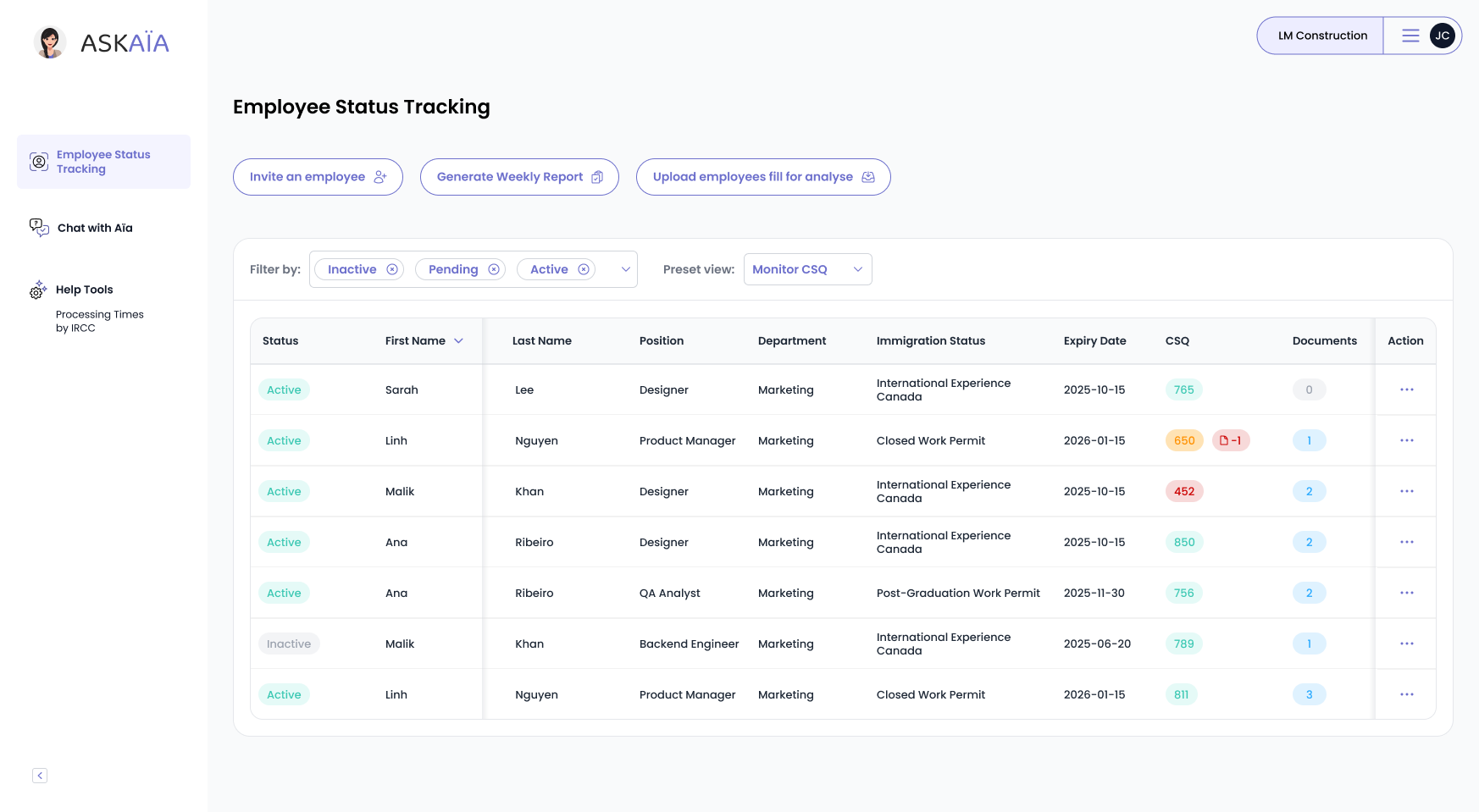Why Skilled Migrants Prefer Canada Over the U.S. in 2025

Faced with mounting delays and complex visa hurdles in the U.S., a growing number of skilled professionals are turning their eyes north. Canada’s streamlined immigration system—led by Express Entry, which processes applications in as little as four months—is increasingly seen as the faster, fairer alternative for global talent.
This trend is backed by strong data and policy contrasts. In this article, we compare both countries and show how immigrants are acting on these differences.
What you are going to learn in this article
- Key Takeaways
- Why Skilled U.S. Workers Are Choosing Canada in 2025
- 2025 Immigration Comparison: Canada vs. United States
- Opportunities and Barriers for Skilled Immigrants in Canada
- Policy Shifts: Canada Tightens, U.S. Delays Persist
- What Skilled Workers Should Do Before Canada's Window Narrows
- Why Acting Now Could Be Your Advantage
Key Takeaways
- U.S. visa caps and slow processing push migrants north.
- Canada's Express Entry offers 4-month processing for skilled workers.
- U.S. Green Cards can take up to 30 months with audits.
- Provinces like B.C. are easing foreign credential recognition.
- Canada's post-2024 immigration slowdown may limit future intake.
Why Skilled U.S. Workers Are Choosing Canada in 2025
Since 2016, a growing number of skilled non-citizens living in the U.S., often on temporary visas like H-1Bs, have increasingly sought permanent residency in Canada. The 2016 U.S. election marked a turning point, with immigration-related Google searches like “move to Canada” reaching all-time highs.
Recent reports from StatCan and media sources confirm the shift: the number of non-citizen U.S. residents immigrating to Canada climbed sharply from 2,100 in 2016 to over 9,300 annually by 2019, a fourfold increase, driven largely by professionals in tech, healthcare, and academia seeking faster, more stable immigration pathways.
2025 Immigration Comparison: Canada vs. United States
Ready for a reality check? The table below is your 2025 immigration scoreboard—processing speed, visa caps, and credential hurdles, revealing exactly how Canada pulls ahead of the United States.
| Metric | Canada | United States |
| PR processing time | Avg. 4.1 months (Express Entry) | Avg. 6.9 months (Green Card - I-485) |
| Work permit route (employment-based) | PNP: 20 months | PERM: 15–30 months |
| PR targets (2025) | 395,000 | ~1,000,000 Green Cards |
| Foreign credential policy | Provincial reforms underway | No unified system |
Opportunities and Barriers for Skilled Immigrants in Canada
Canada’s transparent points system and fast PR pathways are attractive, especially to U.S.-based workers frustrated by slow, uncertain Green Card processes. Programs like Express Entry and the Provincial Nominee Program offer clear, merit-based criteria that reward education, work experience, and language skills, giving applicants more control over their immigration outcomes.
Still, Canada isn't perfect. Many newcomers experience "brain waste," where they are unable to work in their trained profession due to licensing barriers or lack of recognition for foreign degrees. This mismatch leads to underemployment, particularly in fields like engineering, healthcare, and education.
Reforms are underway, British Columbia, for example, has introduced faster pathways for internationally trained doctors and nurses to get licensed and start working sooner. Nationally, there’s growing pressure to expand these reforms across all provinces and professional sectors, ensuring skilled immigrants can fully contribute to the workforce.
Policy Shifts: Canada Tightens, U.S. Delays Persist
Since 2024, Canada has adopted a more cautious approach to immigration, reducing its permanent resident intake target to 395,000 for 2025, down from 485,000 in 2024. Temporary immigration programs, particularly in the low-wage and post-pandemic recovery streams, have also been scaled back or paused in response to public pressure and housing constraints.
At the same time, Immigration, Refugees and Citizenship Canada (IRCC) is focusing on better alignment between immigration levels and infrastructure capacity, including health care, education, and housing services. This recalibration may slow down new intakes but aims to ensure smoother integration.
Still, compared to the U.S., where Green Card applicants often face lengthy audits, multi-year backlogs, and inconsistent policy changes, Canada maintains a more transparent and often faster immigration process. Skilled workers with targeted profiles in healthcare, tech, and trades continue to benefit from expedited PR pathways like Express Entry and category-based draws.
What Skilled Workers Should Do Before Canada's Window Narrows
If you're a skilled worker in the U.S. on a temporary visa, such as H-1B, TN, or OPT, this may be a pivotal moment to explore your Canadian options. Processing delays, political uncertainty, and increasing competition for U.S. permanent residency are pushing more professionals to look north.
Canada’s Express Entry system remains one of the fastest global immigration routes, with average processing times of 4.1 months for eligible applicants. Provincial Nominee Programs (PNPs) also offer tailored options for those with regional ties or in-demand occupations. In both cases, having a valid language test, educational credential assessment (ECA), and a job offer can significantly boost your score.
If you're in healthcare, STEM, or skilled trades, your profile is in high demand across several provinces. But before applying, ensure your academic and professional credentials are recognized by the appropriate regulatory bodies in Canada. A proper credential assessment or provincial bridging program may be required.
Why Acting Now Could Be Your Advantage
Canada remains a top destination for skilled workers due to its stable political climate, transparent immigration system, and fast-track permanent residency options. While 2025 brings signs of moderation in immigration targets, the core structure of Express Entry and provincial programs continues to favour high-skilled professionals.
However, this window of opportunity may not remain open indefinitely. Ongoing reviews by Immigration, Refugees and Citizenship Canada (IRCC) could result in program adjustments, new occupational priorities, or caps on temporary permits, making it critical to act while pathways remain accessible.
If you're weighing your options, take AskAïa’s free assessment today, it instantly scores your profile for Express Entry and PNP streams, highlights any missing documents, and shows whether you should apply now before policy tightening makes qualifying tougher.

Let’s get your demo started
Book a demo
You May Also Like
These Related Stories

Why More U.S. Residents Are Now Choosing to Immigrate to Canada
Tired of visa lotteries and long waits? You're not alone. More and more people—especially skilled, educated workers—are giving up on the U.S. system a …

Canada Extends Ukrainian Immigration Measures Until 2026 – Key Updates
On February 27, 2025, Canada extended key immigration measures for Ukrainians fleeing the war until March 31, 2026. Marc Miller announced that those w …

Unlock Permanent Residence: Use French to Boost Immigration
Canada is opening doors for French-speaking immigrants in Quebec and across the country. Mastery of the French language is becoming a powerful tool fo …